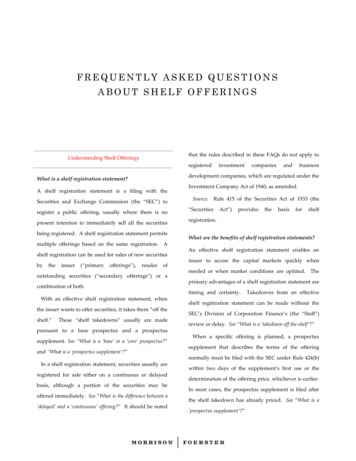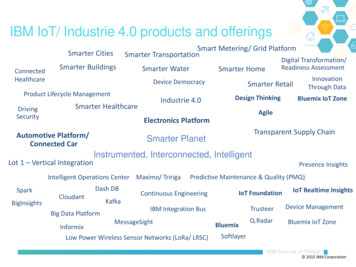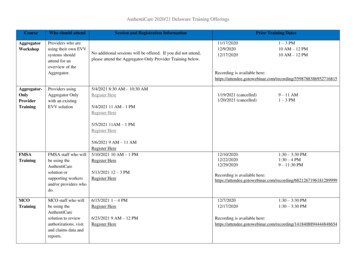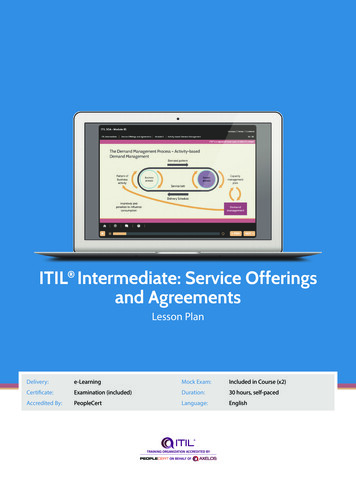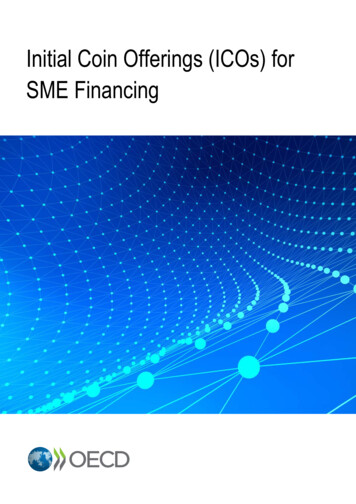
Transcription
Initial Coin Offerings (ICOs) forSME Financing
2Please cite this publication as:OECD (2019), Initial Coin Offerings (ICOs) for SME ngs-for-sme-financing.htmThis work is published under the responsibility of the Secretary-General of the OECD. The opinions expressed andarguments employed herein do not necessarily reflect the official views of OECD member countries. This documentand any map included herein are without prejudice to the status of or sovereignty over any territory, to the delimitationof international frontiers and boundaries and to the name of any territory, city or area. OECD 2019
3ForewordDistributed Ledger Technologies (DLT) like blockchain are a relatively recentarrival in the world of finance, but are already driving new forms of financial innovation,new breeds of financial products, and creating new processes and platforms. Initial CoinOfferings (ICOs) are one of the most prominent applications of blockchain for finance,allowing for an innovative and inclusive way of financing for small and medium-sizedcompanies (SMEs). Over the past two years the use of ICOs has gone from ‘too small tocare’ to ‘too big to ignore’ for markets and regulators alike.Much of the discourse around ICOs to date has focused on the uncertainty of theapplicable regulatory framework for ICOs and crypto-asset markets. This report takes theanalysis further, discussing “tokenomics” and limitations in ICO structuring which can giverise to conflicts of interest and expose investors to significant risks. It analyses issuesaround valuation, accounting and allocation of value, as well as trading of tokens. Ithighlights the importance of network effects as a source of value creation in ICO offeringsand the limits to the use of ICOs as a “mainstream” financing tool.Policy makers have a central role to play in addressing the market and conduct risksinvolved in ICO structures. We need greater clarity in the regulatory and supervisoryframeworks applied to ICOs, as a stepping stone to their safer use for financing purposes.Clear AML/CFT requirements, financial consumer protection safeguards and enhanceddisclosure are some of the actions required. A proportionate regulatory approach canaddress key requirements without stripping away ICOs’ speed and cost advantages.International cooperation is also important. ICOs are global in nature and tradeeasily across borders. A more coordinated global approach is necessary to preventregulatory arbitrage and allow ICOs to deliver their potential for the financing ofblockchain-based SMEs, while also adequately protecting investors.Greg MedcraftDirectorOECD Directorate for Financial and Enterprise AffairsINITIAL COIN OFFERINGS (ICOS) FOR SME FINANCING OECD 2019
4AcknowledgementsThe report has been prepared by Iota Kaousar Nassr under the supervision ofMamiko Yokoi-Arai from the Division of Insurance, Private Pensions and FinancialMarkets of the OECD Directorate for Financial and Enterprise Affairs. Flore-Anne Messyand Greg Medcraft provided advice and feedback. Pamela Duffin and Arianna Ingleprovided editorial and communication support.The report has benefited from input and guidance by the Committee on FinancialMarkets where it was discussed in October 2018.This report contributes to the OECD Going Digital project which provides policymakers with tools to help economies and societies prosper in an increasingly digital anddata-driven world. For more information, visit www.oecd.org/going-digital.INITIAL COIN OFFERINGS (ICOS) FOR SME FINANCING OECD 2019
5Table of contents1. Initial Coin Offerings (ICOs) for SMEs . 91.1. Introduction. 92. The importance of the ecosystem for ICOs: Network effects . 102.1. ICO ecosystems . 102.2. Network effects: an important value creator in ICOs . 113. "Tokenomics": the economics of ICOs . 143.1. Structuring of ICO offerings . 143.1.1. Pre-ICOs . 163.2. Token valuation and pricing . 173.2.1. Accounting for tokens . 183.3. Secondary markets and token-holder returns . 193.4. The costs of an ICO offering . 204. ICOs vs. traditional financing channels for SMEs . 244.1. ICO vs. IPO. 244.2. ICO vs. crowdfunding. 264.3. ICO vs. venture capital . 285. ICOs for SMEs. 305.1. Benefits of ICOs for SMEs . 305.2. Limitations of ICOs for SMEs . 325.2.1. Regulatory uncertainty . 325.2.2. Issues related to the structuring of token offerings . 335.2.3. Investor protection. 345.2.4. Corporate governance and regulatory compliance . 355.2.5. Operational and business risks . 375.3. Can ICOs become a mainstream financing mechanism? . 395.4. Policy and regulatory considerations . 40Annex A. An ICO primer . 42The ICO process . 42ICO-generated tokens . 45Enabling technology. 45Definitions and rights . 45Token classification. 47Regulatory framework. 47ICO activity . 49Annex B. Selected regulatory responses to Initial Coin Offerings worldwide . 51European Union. 51Outside European Union . 57REFERENCES . 66INITIAL COIN OFFERINGS (ICOS) FOR SME FINANCING OECD 2019
6FiguresFigure 4.1. ICO process vs. IPO process . 24Figure 4.2. ICOs vs. IPOs . 26Figure 5.1. Benefits of ICOs. 32Figure 5.2. Estimates of ICO Scams . 35Figure 5.3. Limitations of ICO offerings. 38Figure 5.4. The IPO Process . 43Figure 5.5. Participating in an ICO . 44Figure 5.6. Types of token rights. 46Figure 5.7. ICO activity . 50BoxesBox 2.1. Airdrops . 11Box 3.1. Illustrative example of an ICO offering: Filecoin. 23Box 5.1. The DAO offering and the use of the Howey test by the US SEC . 48INITIAL COIN OFFERINGS (ICOS) FOR SME FINANCING OECD 2019
7Executive SummaryInitial Coin Offerings (ICOs) consist of the creation of digital tokens by small companiesto investors, in exchange for fiat currency or first-generation dominant cryptocurrencies,such as the Bitcoin. ICOs are enabled by the use of Distributed Ledger Technologies(DLTs), such as the Blockchain, which facilitate the exchange of value without the needfor a trusted central authority or intermediary, allowing for important efficiency gainsdriven by such disintermediation.ICOs are having a moment, with much media coverage and hype around their potential forprofit making. This extends to their potential to address the SME financing gap. ICOsenable value creation through the potential development of network effects and efficiencygains driven by the use of the blockchain. Although the lack of regulatory clarity currentlyexposes ICO participants to some risks, ICOs have the potential to offer a new way to raisecapital for projects enabled by DLTs and the blockchain, benefiting from efficiencies, costsavings and speed of execution, if appropriately regulated and supervised.Regulated ICOs can be a more inclusive financing vehicle by allowing small retailinvestors to participate in the financing of small businesses and start-ups. Depending onthe type of rights assigned to ICO tokens, companies can raise risk capital without sharingownership, addressing one of the main impediments to the use of public equity financing(dilution). SMEs are granted direct access to an unlimited investor pool and the liquidityof tokens issued in ICOs is one of most important benefits of ICOs when compared toconventional start-up financing mechanisms such as Venture Capital (VC) funding.Despite these potentials, ICOs in their current shape and form carry important risks forSME issuers and investors subscribing to token offerings. These are mainly linked to theuncertainty of the applicable regulatory framework for ICOs and crypto-asset markets,coupled with the lack of financial consumer protection safeguards, limitations in thestructuring of ICOs and operational risks related to DLTs, exposing investors subscribingto ICO offerings and SMEs issuing tokens to significant risks.Issues around pre-ICOs present potential conflicts of interest arising from the pre-sale oftokens at heavy discounts that hold exactly the same risk as the ones purchased by investorsat the offering stage. In addition, the absence of skin-in-the-game by issuers who do nottake any personal financial risk poses another source of potential conflicts.Most ICO offerings do not fit the standard investment paradigm, inter alia because of theways value is created and attributed between the different participants of a network and thedifficulty in quantifying that effect. Sharing and allocating the value created by tokens maynot always be straightforward given the duality of the token’s function both as a means torepresent the future value of the company (similar to an equity share) but also as a meansto transact on the platform or get access to the platform (usage or utility). UnderstandingICO structuring is a pre-requisite for the valuation and pricing of tokens by SMEs andinvestors subscribing to ICO offerings.The listing and active trading of a token in a crypto-exchange or crypto-trading platform isconsidered as a proxy for the success of th
ICO structuring is a pre-requisite for the valuation and pricing of tokens by SMEs and investors subscribing to ICO offerings. The listing and active trading of a token in a crypto-exchange or crypto-trading platform is considered as a proxy for the success of the ICO and an important factor for the future viability of the business. Market returns of ICO tokens have been found to carry some



